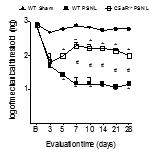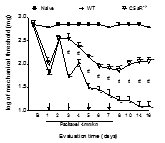Print version
Search Pub Med
ROLE OF COMPLEMENT C5A COMPONENT IN THE DEVELOPMENT AND MAINTENENCE OF CHRONIC NEUROPATHIC PAIN One of the main challenges in analgesic therapy is the treatment of chronic pain, especially neuropathic pain. There is a growing body of evidence suggesting that neuro-immune interaction in the periphery and central nervous system play a crucial role in the induction and maintenance of neuropathic pain. Among these mechanisms, the complement fragment C5a seems to be involved, although little is known about the mechanisms by which this mediator participate in this condition. In the present study, the peripheral involvement of C5a in the genesis of neuropathic pain was studied using male Balb/C mice, WT (wild type) and C5aR-/- mice (knock-out), following the IASP’s and Ethics Committee of the University of São Paulo rules (protocol 120/2014), using von Frey hair and Hargreaves measured mechanical and thermal nociceptive threshold, respectively. Two different models of peripheral neuropathy were induced: partial sciatic nerve ligation (PSNL) and chemotherapy-induced peripheral neuropathy (CIPN), with intraperitoneal administration of paclitaxel 4 mg/kg on days 1, 3, 5 and 7. Furthermore, release of cytokines and chemokines at the site of injury (sciatic nerve), in PSNL model, was quantified by ELISA 6, 12, 24 and 72 hours after surgery (as curve previously determined). Data are expressed as the mean ± SEM. Our results revealed that WT animals submitted to PSNL and CIPN models showed reduced nociceptive threshold compared to the sham/naive groups. On the other hand, C5aR-/- mice develop significantly lower mechanical hypersensitivity than WT animals during the time course (Fig.1 and Fig 2). Thermal hypersensitivity was also reduced in C5aR-/- mice compared with WT mice in PSNL model (Sham: 13.21 ± 0.16; WT: 9.86 ± 1.31; C5aR-/-: 11.61 ± 0.5 sec, n=8) and during CIPN (Vehicle: 13.58 ± 13; WT: 9.49 ± 0.44; C5aR-/-: 11.87 ± .20, =8). Interestingly, neutrophil migration (MPO activity) to the site of neuronal injury and the production of neutrophil attractant chemokines (CXCL1, and CXCL2) was similar in WT and C5aR-/- mice after PSNL. On the other hand, ELISA assay showed that concentration of cytokines/chemokines (pg): CCL2 and 3, are significantly reduced in samples of sciatic nerve, after PSNL, in C5aR-/- compared to WT mice, between 12 and 72 hours after surgery, while CCL4, IL-1β and TNF-α was reduced between 24 and 72 hours. Fig. 1 Mechanical threshold after PSNL
Fig 2. Mechanical threshold after paclitaxel treatment
*P<0.05 compared to sham/naïve; #P<0.05 C5aR-/- compared to WT group. In conclusion the C5a/C5aR signalling participates in the genesis of chronic pain in different models of neuropathy caused by traumatic or chemical injuries. Moreover, this signalling seems to regulate the production of chemokines at the site of neuronal damage.
|



